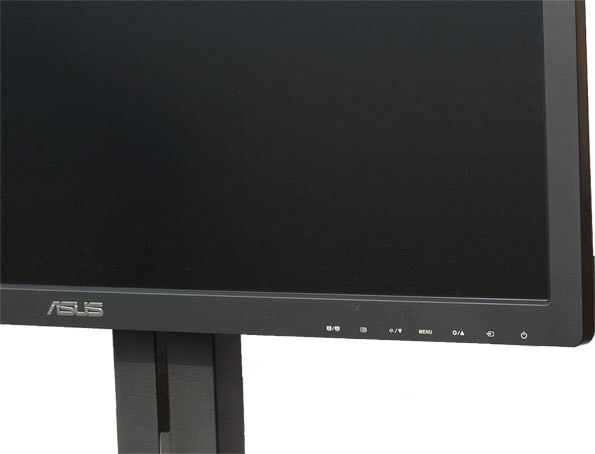ASUS PB278Q 27-inch WQHD Monitor Review
Calibration & Controls
ASUS claims each PB278Q comes pre-calibrated at the factory, which means you should be able to turn it on and get straight to work without worrying about fine tuning the settings. Should you still decide to tweak the settings, ASUS includes of a set On-Screen Controls (OSD).
The OSD controls are labeled on the bottom right corner of the monitor, with the actual buttons hidden underneath the bezel. These are large, physical buttons that are easy to find in the dark, though they're not visible unless you poke your head under the monitor. The labels, however, do not light up, so fiddling with the controls in the dark can be an exercise in frustration.

Like most monitors, there are several presets profiles to choose from. These include Scenery, Theater, sRGB, Standard, and two user-customizable modes. The mode you choose determines which of the OSD settings you can adjust.
Once you're inside the settings, you're able to adjust things like the brightness, contrast, sharpness, "Trace Free" (speed up the response time by Over Drive technology), aspect ratio, over scan (only available for HDMI input), saturation, hue, and more.

Like most monitors, there are several presets profiles to choose from. These include Scenery, Theater, sRGB, Standard, and two user-customizable modes. The mode you choose determines which of the OSD settings you can adjust.
| Function |
Standard Mode |
sRGB Mode |
Scenery Mode |
Theater Mode |
User Mode |
| Brightness | Yes |
Yes | Yes | Yes | Yes |
| Contrast | Yes | No |
Yes | Yes | Yes |
| Saturation | No | No | Yes | Yes | Yes |
| Hue | No | No | No | No | Yes |
| Color Temperature |
Yes | No | Yes | Yes | Yes |
| Gamma | Yes | No | No | No | Yes |
| Gain (Advanced) |
No | No | No | No | Yes |
| Offset (Advanced) | No | No | No | No | Yes |
Once you're inside the settings, you're able to adjust things like the brightness, contrast, sharpness, "Trace Free" (speed up the response time by Over Drive technology), aspect ratio, over scan (only available for HDMI input), saturation, hue, and more.
|
We're now using DisplayMate for Windows (www.displaymate.com) as part of our monitor evaluation process. DisplayMate's smorgasbord of tests allow us to root out potential problems areas, such as geometry distortion and color inaccuracies, to name just two.
As we're mostly accustomed to IPS panels in high-end displays, we didn't know quite what to expect from the PLS screen. For the most part, we were pleasantly surprised. For as bright and vibrant as the PB278Q is capable of getting, we were happy to see that backlight bleeding was a non-factor. We were also impressed with its black level performance in sRGB mode (black level performance suffered slightly in Standard mode, and significantly in all the other modes). White and gray levels were also very good on the PB278Q.
We did notice a small amount of overshooting in the video bandwidth test. A perfect video bandwidth score in DisplayMate is 100; the PB278Q scored a 110. According to DisplayMate, a high video bandwidth score can result in ringing and overshooting of images, though the PB278Q scored close enough to 100 that we were unable to detect these anomalies in real world testing. Another issue that came up was a bit of flickering in the Moire interference test pattern, an effect that has a tendency to crop up in high resolution displays with finely focused beams. Finally, text lost some of its sharpness at small font sizes, though otherwise was easy on the eyes.

As we're mostly accustomed to IPS panels in high-end displays, we didn't know quite what to expect from the PLS screen. For the most part, we were pleasantly surprised. For as bright and vibrant as the PB278Q is capable of getting, we were happy to see that backlight bleeding was a non-factor. We were also impressed with its black level performance in sRGB mode (black level performance suffered slightly in Standard mode, and significantly in all the other modes). White and gray levels were also very good on the PB278Q.
We did notice a small amount of overshooting in the video bandwidth test. A perfect video bandwidth score in DisplayMate is 100; the PB278Q scored a 110. According to DisplayMate, a high video bandwidth score can result in ringing and overshooting of images, though the PB278Q scored close enough to 100 that we were unable to detect these anomalies in real world testing. Another issue that came up was a bit of flickering in the Moire interference test pattern, an effect that has a tendency to crop up in high resolution displays with finely focused beams. Finally, text lost some of its sharpness at small font sizes, though otherwise was easy on the eyes.

The few issues notwithstanding, the PB278Q is capable of displaying bright, crisp, and vivid photos with relative ease. However, we noticed that images and colors weren't as deep and didn't pop the way they do on some other professional grade monitors we've tested, like Dell's U3011. You can tweak the settings to come close to the same performance, but it will still fall a little short in a head-to-head comparison.











